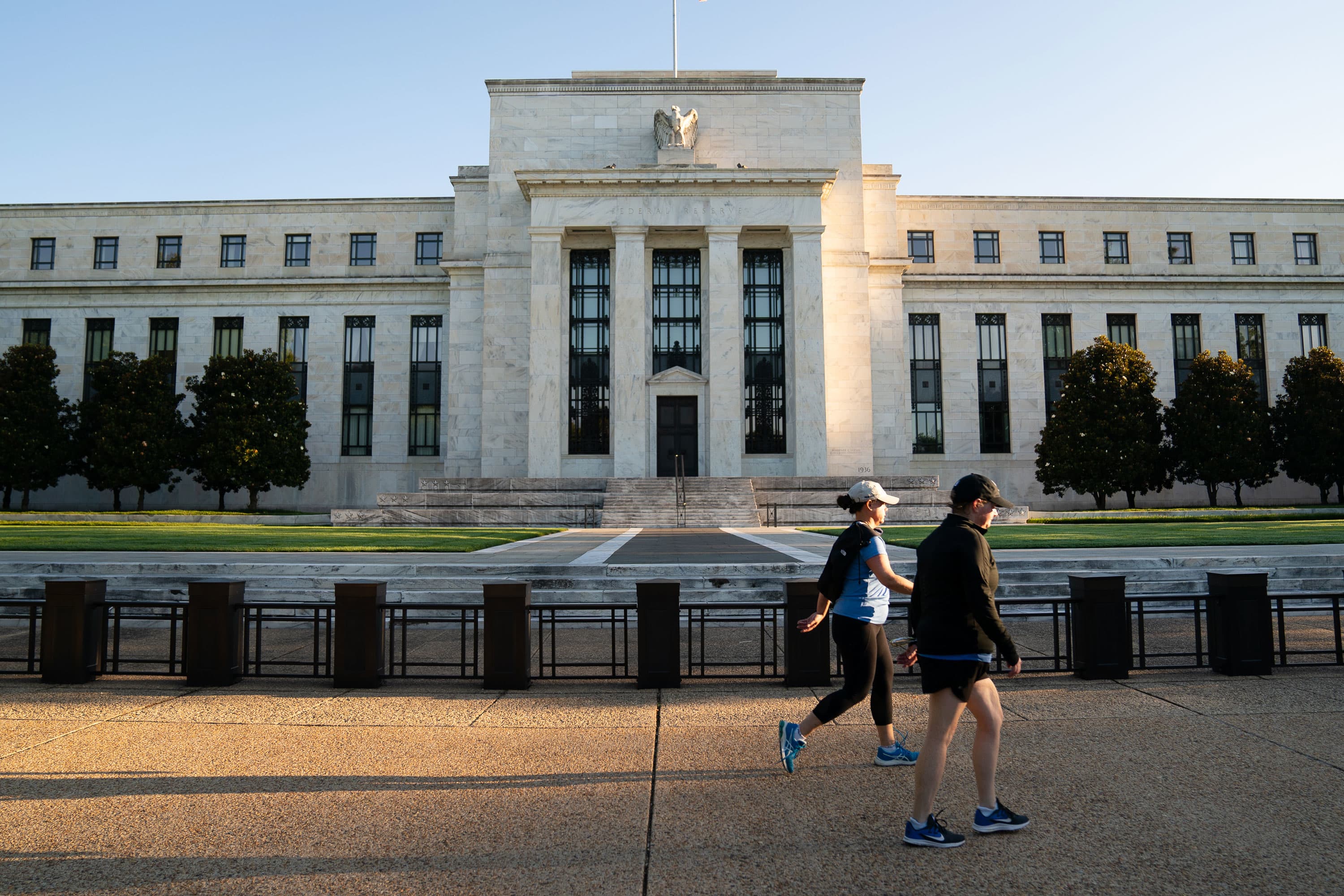Joggers pass the Marriner S. Eccles Federal Reserve building in Washington, D.C., on Tuesday, Aug. 18, 2020.
Erin Scott | Bloomberg | Getty Images
Interest rates near zero likely will stay in place not for months but instead years as the Federal Reserve seeks to re-engineer an economy characterized by low inflation and an uneven labor market.
Wall Street is prepping for a return to the post-financial crisis days, when rock-bottom short-term rates prevailed for seven years before the Fed even tried moving them higher.
Fed officials have outlined a revised policy in which it now will target “average inflation,” meaning a higher tolerance for inflation above 2% before hiking interest rates from current levels. In the past, the Fed would look to rate cuts when unemployment began to fall as a sign that inflation would not be far behind.
In the present circumstances, then, the remaining question will be how deep the Fed’s commitment to inflation will run, what will be considered full unemployment, and how many years that will mean for zero interest rates.
“These are all open-ended questions. The answer is, we don’t know nor does the Fed know. They just know what they want to see,” said Quincy Krosby, chief market strategist at Prudential Financial. “It’s lower for considerably longer, if you believe as the Fed does that the recovery in the economy and the labor market is going to take years.”
Fed Chairman Jerome Powell laid out the strategy in a speech Thursday during which he spoke of an enhanced approach to inflation and a philosophy on employment that isn’t merely looking at a certain level anymore but rather is targeting the distribution of gains along the income spectrum.
In an appearance Monday, Fed Vice Chairman Richard Clarida elaborated on the policy with a number of notable comments.
Clarida said the Fed won’t be hiking rates just because unemployment drops to a certain level, and emphasized that hitting the inflation target in a sustainable manner would require an “asymmetric” policy response, a contrast to the oft-stated goal of hitting inflation in a “symmetric” manner, meaning that periods of cooler or hotter inflation would be tolerated so long as the longer-run level ran around 2%.
Moreover, he acknowledged that some of the models the Fed has followed for rate hikes likely were wrong. One such model that Clarida did not mention by name is the Phillips Curve, which maps the relationship between unemployment and inflation and has many adherents in economic circles.
Now, he said, the Fed is more committed to make sure its goals are hit and will be using aggressive policy to get there.
“We’re willing to allow the economy to operate at full strength even if it means a modest overshoot of the inflation objective,” Clarida said.
Missing the goalpost
For now at least, an overshoot seems optimistic.
After all, the Fed has spent most of the past 12 years unable to hit its objective on inflation, which it considers essential to a growing economy that provides enough policy room to adapt in the case of downturns. In the current cycle, prevailing low rates left the Fed with only 1.5 percentage points to cut when the coronavirus pandemic crisis hit.
Wall Street economists see a period of several years before the Fed is able to hike again.
Goldman Sachs, for instance, estimates policy “liftoff” that would come “around early 2025,” depending on the metrics the Fed wants to use. One of the questions would be how far back the Fed would want to calculate to come to an “average” that would then be used to clear the way for policy normalization once inflation took hold.
Others on Wall Street see a five-year time frame as realistic as well.
Tony Dwyer, an analyst Canaccord Genuity Capital Markets, said the Fed will combine low rates with a prolonged campaign of quantitative easing, the bond-buying program that has helped add nearly $3 trillion to the central bank balance sheet since the pandemic began.
“Our take is their statement means the Fed is going to remain historically accommodative for a very long time and the economic cycle has a very long way to go,” Dwyer said in a note. “The Fed has now publicly stated they won’t be raising rates even if inflation begins to pick up, and that a strong economy accompanied by full employment will not cause them to take preemptive action to tighten due to inflation fear.”
Dwyer sees “a zero-interest-rate policy and open-ended quantitative easing (QE) for the next five years,” as government debt piles up and the Fed is called on to underwrite trillions in stimulus spending.
“We believe the new monetary policy initiative announced by Fed Chair Powell at Jackson Hole, coupled with the synchronized global economic recovery, suggests we are in the very early stages of a new economic and market cycle that should last years,” he said.
Morgan Stanley equity strategist Michael Wilson said the Fed’s efforts to keep short-term rates low are likely to lead to higher longer-term rates, which the market has not priced in.
“The bottom line is that back end rates are mispriced and everyone knows it. The only thing holding them down has been a belief that the Fed won’t allow it,” Wilson wrote. Higher long-term rates “are a good thing because [they] will help the Fed achieve its goal of higher and more sustainable inflation via the banking system which requires steepness in the curve.”
Investors, then, are back in a familiar position of don’t-fight-the-Fed as the central bank’s efforts to steer the economy back onto solid ground will involve a prolonged episode of management that will tamp rates down no matter what the markets want.
“The job of a trader is to trade the market you have, not the market you want,” Prudential’s Krosby said. “If you disagree with that, your performance can suffer considerably.”
